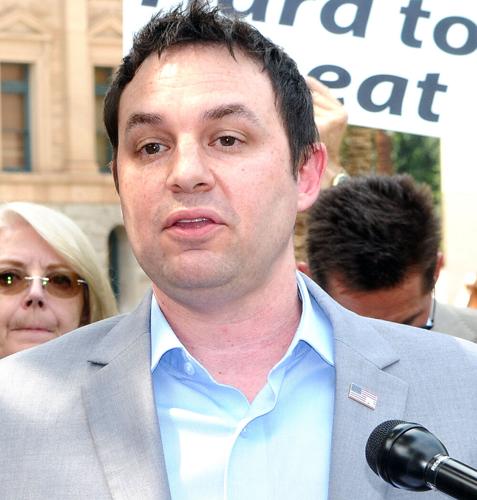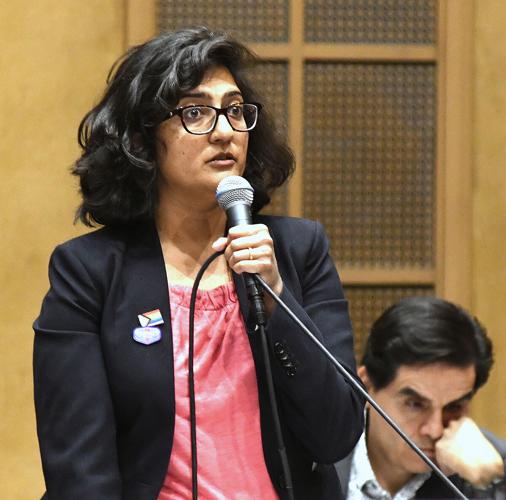PHOENIX — Most of the attention to ballot measures set for votes this year has been focused on a few high-profile issues, such as the right to abortion and new laws on border security.
But buried in the 13 measures going to voters in November is one asking them to give up some of their rights to make laws in the first place.
Proposition 134 would require that any group circulating initiative petitions get a certain percentage of their signatures from all 30 legislative districts in Arizona. That would override existing constitutional provisions that have no such geographic requirement.
Sen. J.D. Mesnard, a Chandler Republican who crafted the measure, said it ensures that those in rural areas have some say in what goes on the ballot. He said they often are overlooked at this stage of the lawmaking.
As it is now, he said, circulators could get all the signatures they need in just a few areas — or even in one county.

Sen. J.D. Mesnard
But Tucson Democratic Sen. Priya Sundareshan called it a “false narrative’’ to suggest the existing constitutional requirements about where signatures can be gathered give residents of one area of the state more power over others. She said it’s no different than what happens in an election when all voters from all counties get a chance to decide whether to support a measure.
What Prop. 134 would do, she said, is give residents of any one area of the state veto power over what Arizonans from everywhere else might want: If enough voters of one district decline to sign, then no one in the state gets the opportunity to decide the matter.

Sundareshan
Sundareshan said that is more than an academic question.
She pointed out that many of the 30 legislative districts are drawn in a way to give one party or the other an overwhelming majority. And the residents there could be hostile to something voters statewide — nearly evenly divided among Republicans, Democrats and political independents — may want.
Constitutional authority
Central to the issue is the intent of the people who wrote the Arizona Constitution.
On one hand, the constitution says the power to make laws is “vested in the Legislature.’’ But it doesn’t stop there.
“The people reserve the power to propose laws and amendments to the constitution and to enact or reject such laws and amendments at the polls, independently of the Legislature,” it says.
Put simply, it gives voters a chance to act when their elected officials will not.
Arizonans took advantage of that almost immediately, approving the right of women to vote in 1912 by a margin of more than 2-1. That was eight years before the 19th Amendment to the U.S. Constitution was approved.
More recently, some groups have moved to erect new hurdles to voters bypassing lawmakers. These include new registration rules for paid circulators, limiting the number of subjects that can be in an initiative, and giving courts the authority to disqualify measures if there has not been “strict compliance’’ with all election laws. Prior to that 2017 change, all that was required was “substantial compliance.’’
The latest effort is Prop 134.
Under existing constitutional requirements, someone proposing a new law needs signatures equal to 10% of the people who cast ballots in the last gubernatorial election.
In 2022, 2.56 million people made a choice for governor. That makes the current minimum for a statutory initiative 255,949. Constitutional changes require 15%, or 383,923.
The proposed changes
Mesnard and his allies, including the Goldwater Institute and the Arizona Free Enterprise Club, got the Republican-controlled Legislature to put the measure on the ballot, saying those percentages apply not statewide but to each legislative district.
There is no readily available source detailing gubernatorial votes by legislative district. Generally speaking, however, under Arizona law, all legislative districts are supposed to have roughly equal population.
Assuming that rough math, it would mean a proposed statutory change would have to get at least 8,500 signatures in each of the 30 districts, whether it includes a densely packed urban district or a far-flung rural district like the one that runs from the edge of Flagstaff, through portions of Navajo and Gila counties to the outskirts of Florence and the Pima County line.
If circulators didn’t get the requisite 10% from that district, or any other, the proposal wouldn’t make it to the ballot.
“What this actually does is it privileges the voters of a particular district who may decide to withhold their signatures,’’ Sundareshan said.
Mesnard said the extra check is necessary.
He said initiatives, in bypassing the Legislature, also bypass the kind of debate and compromise that takes place at the Capitol. That includes input from the public and special interests who would be affected, allowing for changes — or killing the idea if it can’t get a majority.
“If we’re going to bypass that whole process, let’s make sure it’s an issue that has buy-in from all over the state, not just Maricopa County or one particular part,’’ he said.
Initiatives in recent years
But history also has shown that some legislators and the business interests that support them generally do not like voters making their own laws. Instead, they prefer a process of lining up votes at the Capitol, a process that for decades has been dominated by Republicans.
The legislative process, however, also works in reverse: It can be used to block approval of measures that business interests do not want. That, in turn, has resulted in voters going to the ballot.
That’s what happened in 2006 and again in 2016 when voters, gaining no traction at the Capitol, decided Arizona workers should have a minimum wage higher than the $7.25 required under federal law, a figure that has not changed since 2009. Arizona now has a minimum wage of $14.35 an hour.
There are other examples of Arizonans taking matters into their own hands when lawmakers refused to act.
In 1994, voters approved a ban on leghold traps, snares and poisons on public lands over the objections of hunters and some rural residents. Four years later, after lawmakers refused to take up the issue, foes of cockfighting got a ban on the ballot and got it approved.
Marijuana became legal for medical use in 2010 because voters mandated it. A decade later, the same process was used to make the drug available to all adults.
And in 2006, voters decided that farmers could no longer keep pigs in gestation crates and calves in confinement crates. Now, groups such as the Arizona Farm Bureau Federation, which unsuccessfully fought that measure, support what Mesnard is trying to do.
Sundareshan said the process works fine just the way it is. She noted that for any proposal to become law, it has to be approved by a majority of the voters who turn out for the general election.
“Once it gets onto the ballot, every single voter has an equal vote in the yes/no of that initiative,’’ she said.
That’s true, Mesnard said. And nothing in Prop. 134 would eliminate the ability of a majority of voters — even if all from urban areas — to enact a change at the general election.
But under Prop. 134, it might not get that far: If proponents can’t get sufficient rural signatures, it wouldn’t get to the ballot.
Backers and foes
Because of the ability of rural interests and others to block things at the Legislature, such as limits on leghold traps, people like Sandy Bahr of the Sierra Club say voters statewide need the ability to bypass lawmakers without any new hurdles.
Others who have previously gone directly to the public — or intend in the future — to get action on issues also registered their displeasure with Prop. 134, ranging from Save Our Schools and the NAACP to Planned Parenthood, the ACLU and Living United for Change in Arizona.
By contrast, supporters of the additional hurdle include the Arizona Citizens Defense League, United Dairymen of Arizona and the Arizona Farm Bureau Federation, the Free Enterprise Club and various chambers of commerce.
Jenna Bentley of the Goldwater Institute, which wants the change, said the higher burden is legal.
She cited a 2012 ruling by the 9th U.S. Circuit Court of Appeals — the circuit whose rulings govern Arizona — upholding a Nevada measure that imposes a 10% signature requirement in each of that state’s congressional districts. There, the judges said there’s nothing wrong as long as all the districts are equal in population.
While the initiative process has largely been the tool of what might be considered progressive or liberal interests, that isn’t entirely the case.
A 1992 voter-approved measure requires proof of citizenship and identification to cast a ballot.
Arizonans also decided to put a provision in the Arizona Constitution declaring “only a union of one man and one woman shall be valid or recognized as a marriage in this state.’’ That was subsequently declared unenforceable by federal courts, though the language has not been repealed.
Get your morning recap of today's local news and read the full stories here: tucne.ws/morning





